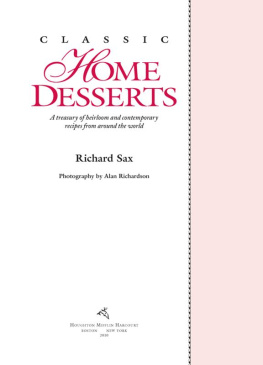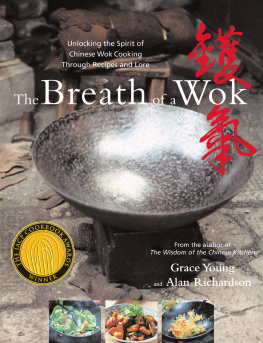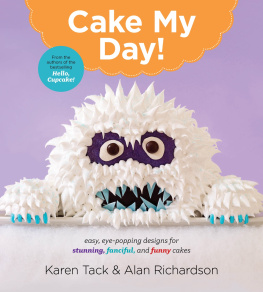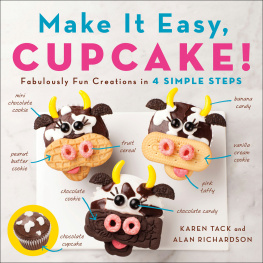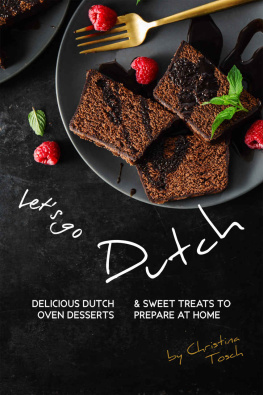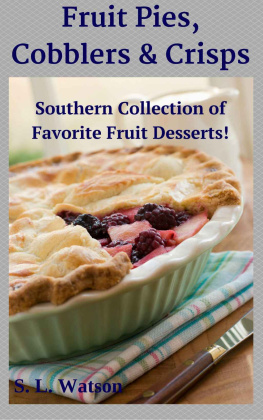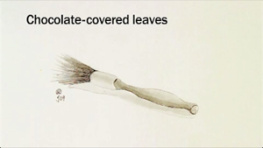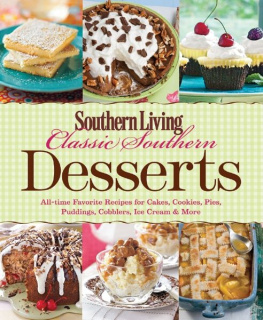Copyright 1994, 2010 by Richard Sax
Photography 1994, 2010 by Alan Richardson
For information about permission to reproduce selections from this book, write to Permissions, Houghton Mifflin Harcourt Publishing Company, 215 Park Avenue South, New York 10003
www.hmhbooks.com
Library of Congress Cataloging-in-Publication Data
Sax, Richard. Classic home desserts : a treasury of heirloom and contemporary recipes from around the world / Richard Sax; photography by Alan Richardson.p. cm.
Reprint. Originally published: Shelburne, Vt. : Chapters Pub., c1994. Includes bibliographical references and index. ISBN 978-0-618-05708-5 1. Desserts. 2. Cookery, International. 3. Cookbooks. I. Richardson, Alan. II. Title.
TX773.S3177 2010
641.8'6dc22
2010025552
Printed and bound in South China
Designed by Eugenie Seidenberg Delaney
Food styling by Anne Disrude
Prop styling by Betty Alfenito
Cover photograph by Alan Richardson:
Chocolate Cloud Cake,
This is for
Michael Violanti
beloved friend
19481991
Foreword
BY D ORIE G REENSPAN
Theres only one way I could be more thrilled about introducing you to Richard Saxs masterwork, and that would be if I had written it myself. And, now, almost two decades after Classic Home Desserts was first published, I can confess that for all those years I wished Id written it.
I was a beginner cookbook author when Classic Home Desserts hit the stores and, while I had no idea what my future would be, when I bought Richards book it became my ideal. It was that rare book that was both practical and pleasurable, a solid cookbook and a good read, and over the years Ive shuttled it endlessly between an easy-to-reach shelf in my kitchen and a just-as-easy-to-reach table next to my favorite chair.
I came to the book already a fan of Richard. Id followed his work for years, clipping his travel articles, especially the ones from Paris, which appeared in Gourmet; cooking from his column in Bon Apptit; and baking from his Cookie Lovers Cookie Book.
He had talent to burn. He was trained as a chef (he was the founding chef-director of the Food & Wine test kitchen) and was as giftedand as at homewith savory food as he was with sweet. All that and he was eloquently literate, too.
And while I may have wished Id written this book, truly, I knew I couldnt have. No one else could have: It was Richards book through and througha book that grew out of a passion so strong it might just as well have been a quest.
This huge volume had its roots in a slim paperback called Old-Fashioned Desserts that Richard worked on in the early 1980s. As he tells it, even after the book came out, he continued collecting recipes from around the world. He never ceased to be fascinated by them, by how home bakers kept them alive over generations, about what they meant to families and their communities and about the rituals that surrounded them. He loved heirloom recipes and what they told us about the people who made them, and he kept his finger on the pulse of what contemporary home bakers were making.
Whatever you do, dont skip Richards introduction. Of course, it tells the story of how this book took shape, but it also gives voice to something I think all of us who bake at home have felt but might not have been able to express: the power of sharing something we make by hand, something that is always a gift because it is never a necessity.
No one else before Richard, or since, understood the subject of home baking as well, cared about it as deeply, or could tell us about it as beautifully. If he had simply collected the hundreds of quotations, stories, and journal entries that fill Classic Home Desserts, hed have helped us understand how we home bakers are tied to a tradition that reaches back through centuries and across continents, and hed have created a work to cherish. But this is also a cookbook to take into the kitchen, to use until its pages are spattered with butter and dusted with sugar, to keep in the kitchen until weve baked our way through it.
If theres a type of dessert not included in this book, Ive never heard of it, or, as Richard explains, its not a dessert thats made at home. When Richard says these are home desserts, he means it: These are the recipes of moms, not chefs.
Starting with The Extended Family of Cobblers and Crisps, a large family with lots of branches, all of them delicious, Richard takes us through scores of recipes, so many of them based on fruitthere are fruit compotes and puddings, cakes and pies, tarts and pastries. There are cookies, of course, lots of them, and four full chapters on cakes: Plain Cakes and Cakes with Fruit; Coffee Cakes; Layer Cakes, Fancy Cakes, Cheesecakes and Chocolate Cakes; and Fruitcakes and Nut Cakes. Pies and tarts get as many chapters, and no one covers puddings and custards (and even pancakes and dumplings) as lusciously as Richard.
And on nearly every page, theres a story or a brilliant quotationthe amount of research Richard did is almost unfathomablea historical recipe, a piece of fascinating background information, or a tip. On one page it might be instructions for making oatmeal puddings from Lady Anne Mortons handwritten manuscript dated 1693, and on another it might be a note from Richard telling us what the short in shortbread means. The great diarist Samuel Pepys chimes in on fritters; Jack Kerouac has his say on pies on the road; we learn the words to The Hasty-Pudding: A Poem in Three Cantos; and we are touched by the comments of bakers the world over.
Early in Classic Home Desserts, Richard includes a quote from Olene Garland (it comes from The Foxfire Book of Appalachian Cookery, 1984) that has haunted me for years, as much for what it says about a mothers love as for what it says about the meaning dessert holds in our lives: There was ten children in my family, so it was a pretty big chore for Momma to make a dessert for so many, but she was always wanting to treat us.
This is the book for those of us who want to treat the people we love. For two decades, bakers have reached for it to bake for those they care about most. Now, with this new edition, its your turn.
Richard died soon after giving us this treasure of a book. I can only imagine what it would have meant to him to know that, like his beloved home desserts, his work is passing from mother to child, from friend to friend, from generation to generation.
D ORIE G REENSPAN
Introduction
What is patriotism but the love of good things
we ate in our childhood?
L IN Y-T ANG
Over the past several years, while researching the material for this book, I spent much time leafing through the pages of old cookbooks. Some of the most interesting recipes had never been published or even printed but were found in the handwritten manuscripts, where housewives of various periods in various countries had recorded their own family recipes. Scattered among them were home remedies, friends and relatives addresses and other long-lost ephemera.
Sitting for hours in the wood-paneled recesses of the New York Public Librarys rare book and manuscript collection, carefully turning pages copied out in the authors own hand, I became completely absorbed in these old notebooksin their painstaking clarity, their graceful penmanship, the private notes of their owners. I felt as though I was being offered an intimate look into each persons home life and often, a glimpse into something deeper.
One day shortly before Christmas, while perusing a first edition of Mrs. Dalgairns The Practice of Cookery, a seminal book of Scottish cooking published in 1830, I noticed a recipe for seed cake, a traditional fruitcake baked with caraway seeds. While the cake is not served specifically for Christmas in Scotland, it was remarkably similar to other fruitcakes featured at winter festivals. On returning home, I decided to try Mrs. Dalgairns recipe in my own kitchen. I modified a few details, omitting the comfitscaraway seeds dipped in sugar that were strewn over the cakes surfacebut otherwise, I obeyed her instructions to the letter.
Next page
